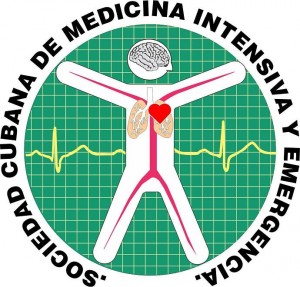Evolution of a critic patient with COVID-19
Keywords:
COVID-19, Intensive care unit, Human ARDS, APACHEAbstract
Introduction: In late 2019, a new coronavirus, called SARS-CoV-2 (Severe Acute Respiratory Syndrome Coronavirus 2), caused an epidemic of acute respiratory disease in Wuhan, China. The World Health Organization named this disease coronavirus disease 2019 (COVID - 19) and on March 11, 2020 it was declared a pandemic.
Objective: To describe the diagnosis, therapeutic behavior and evolution of a critical patient with COVID-19.
Clinical case: The case of a 66-year-old white male patient is reported. He had personal pathological history of arterial hypertension, type II diabetes mellitus and chronic adrenal insufficiency. He first started with fever and asthenia so he went to Enrique Cabrera General Teaching Hospital, where he was admitted to the Intensive Care Unit until the result of positive PCR for SARS-CoV-2 was received. He was transfered to the Intensive Care Unit of Dr. Salvador Allende Clinical Surgical Teaching Hospital to continue treatment. The medical behaviors taken included drug therapy and invasive ventilation. The evolution of the patient was torpid and he died.
Conclusions: The confirmatory diagnosis was made by RT-PCR. The studied patient was of advanced age and had unfavorable prognostic index values. The complements corresponded to the severity of the case. The current Cuban national action protocol for treatment was followed. Comorbidities affected the subsequent evolution of the case. There were multiple complications that led to the death of the patient.
Downloads
References
1. Guan WJ, Ni ZY, Hu Y, Liang WH, Ou CQ, He JX, et al. Clinical Characteristics of Coronavirus Disease 2019 in China. N Engl J Med. 2019 [citado: 14/07/2020];382:1708-20. Disponible en: https://www.nejm.org/doi/full/10.1056/NEJMoa2002032
2. Organización Mundial de la Salud. Los nombres de la enfermedad por coronavirus (COVID-19) y del virus que la causa [citado: 14/07/2020]. Disponible en: https://www.who.int/es/emergencies/diseases/novel-coronavirus-2019/technical-guidance/naming-the-coronavirus-disease-(covid-2019)-and-the-virus-that-causes-it
3. Organización Mundial de la Salud. Alocución de apertura del Director General de la OMS en la rueda de prensa sobre la COVID-19 celebrada el 11 de marzo de 2020. OMS; 2020 [citado: 14/07/2020]. Disponible en: https://www.who.int/es/dg/speeches/detail/who-director-general-s-opening-remarks-at-the-media-briefing-on-covid-19---11-march-2020
4. Ministerio de Salud Pública. Protocolo de actuación nacional para la COVID 19. MINSAP; 2020 [citado: 14/07/2020]. Disponible en: https://files.sld.cu/editorhome/files/2020/05/MINSAP_Protocolo-de-Actuaci%25C3%25B3n-Nacional-para-la-COVID-19_versi%25C3%25B3n-1.4_mayo-2020.pdf
5., Ranieri VM, Rubenfeld GD, Thompson BT. ARDS Definition Task Force: Acute respiratory distress syndrome: the Berlin definition. JAMA. 2012 [citado: 14/07/2020];307:2526-33. Disponible en: https://pubmed.ncbi.nlm.nih.gov/22797452/
6. Massachusetts General Hospital Biostatistics Center. Massachusetts: NHLBI ARDS Network; 2014 [citado: 15/09/2020]. Disponible en: www.ardsnet.org/files/ventilator_protocol_2008-07.pdf
7. Wu Z, McGoogan JM. Characteristics of and Important Lessons from the Coronavirus Disease 2019 (COVID-19) Outbreak in China: Summary of a Report of 72 314 Cases from the Chinese Center for Disease Control and Prevention. JAMA. 2020 [citado: 15/09/2020];323(13):1239-42. Disponible en: https://pubmed.ncbi.nlm.nih.gov/32091533
8. Wang D, Hu B, Hu C, Zhu F, Liu X, Zhang J, et al. Clinical Characteristics of 138 Hospitalized Patients With 2019 Novel Coronavirus–Infected Pneumonia in Wuhan, China. JAMA. 2020 [citado: 15/09/2020];323(11):1061-9. Disponible en: https://jamanetwork.com/journals/jama/fullarticle/2761044
9. Zhou F, Yu T, Du R, Fan G, Liu Y, Liu Z, et al. Clinical course and risk factors for mortality of adult in patients with COVID-19 in Wuhan, China: a retrospective cohort study. The Lancet. 2020 [citado: 15/09/2020];395(10229):1054-62. Disponible en: https://www.thelancet.com/lancet/article/s0140-6736(20)30566-3
10. Serrano JM, Carmona P, Ruiz F, Benítez JA. Métodos de rescate de la hipoxemia severa. En: Vasserot FJ, León C, Reina A, García Á, Robles JC, Pérez AJ, editores. Tratado de medicina intensiva. 1ª ed. Barcelona: Elsevier; 2017. p. 311-24.






